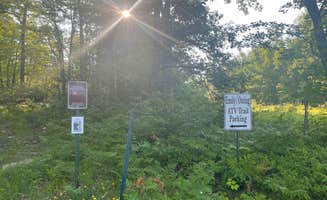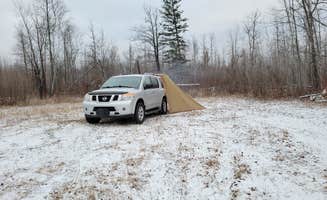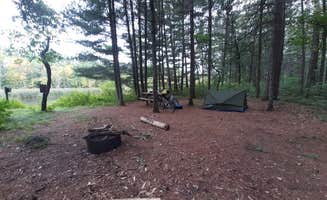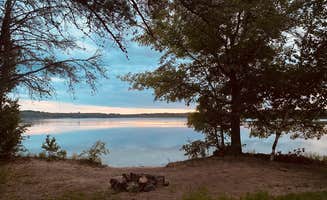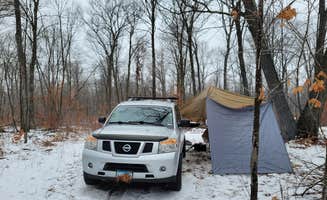Dispersed camping options near Aitkin, Minnesota include several primitive sites across state forests within a 45-mile radius. These backcountry camping areas feature minimal to no facilities, typically situated along forest roads and waterways. Most locations remain open year-round but access varies significantly with seasonal conditions, particularly during spring melt when forest roads may become impassable even for high-clearance vehicles.
What to do
Paddle access camping: The Paul Bunyan Trail Canoe Campsite offers a distinct experience for those traveling by water or trail. As one visitor explains, "This is a beautiful deeply wooded double campsite along the scenic Pine River. It is accessible only by foot, bike or paddle, for trekkers on the Paul Bunyan Bike Trail or the Pine River Water Trail." Paddlers can reach the site between River Mile 35-36, while hikers or cyclists need to travel "about a half mile south down the trail from the Bites Bar and Grill to the turn off west on a dirt trail."
Wildlife observation: The forests surrounding Aitkin support diverse wildlife populations observable from camping areas. Brent G. described his experience at Spider Lake Trail - Dispersed Camping: "Very quiet, no sounds of vehicles or people... The site is smaller. It does overlook a tiny little lake with bird life... Lots of beaver activity as well when circling the nearby lake." Dawn and dusk typically offer the best wildlife viewing opportunities.
Lake access camping: Several primitive sites provide direct lake access for swimming and fishing. Joni Z. noted about Mabel Lake State Dispersed: "I was able to back to the water to have a gorgeous view from bed! It was so quiet last night, although the beaked neighbors get pretty chatty early... There is a large puddle and so many mosquitos." The site includes a "sandy boat launch" making it suitable for small watercraft.
What campers like
Complete solitude: Many campers specifically mention the isolation available at dispersed sites as a primary attraction. Christine H. describes Dago Lake as "God's Country... Quiet aside from the occasional car. Pitch black at night." Similarly, Skip H. found extensive privacy at Rum River State Forest, noting: "The spot I stayed in was the most secluded I could find. It was through a ditch and up a small hill and set back in the woods."
Spacious sites: Several dispersed camping areas provide ample room for larger groups or multiple vehicles. Joni Z. observed that Mabel Lake State Dispersed is "Large enough for multiple campers or a small group. There are four rings and a picnic table as well as a sandy boat launch." Many sites have established fire rings and cleared areas that accommodate multiple tents.
Accessibility options: Despite their primitive nature, some sites remain reasonably accessible. Samuel C. reported about Hill River State Forest: "There were a good amount of spots, and I seemed to be the only person. Was a good and secluded... I made it fine with 2wd, just take it slow." Several areas feature multiple site options with varying levels of access difficulty.
What you should know
Road conditions vary dramatically: Forest roads leading to camping areas require careful navigation. Skip H. warned about Hill River State Forest: "The road does a lot of winding, and sections aren't always in the best shape." Many visitors emphasize proceeding slowly and cautiously, especially after rain or during spring thaw.
Wildlife precautions: Encounters with wildlife require appropriate preparation. Johnny H. reported from Rum River State Forest: "I did hear wolves for the first time. They were howling after sunset. A little creepy, camping alone. But, I don't suspect they'd come too close." Food storage in sealed containers and proper garbage management help minimize wildlife interactions.
Insect protection essential: Multiple reviews mention significant insect activity, particularly during warmer months. Ronney P. noted at Rum River State Forest Dispersed: "nice an quiet, a lot of ticks but had a great time." Bug spray, protective clothing, and regular tick checks are necessary precautions from late spring through early fall.
Tips for camping with families
Site selection considerations: When camping with children, prioritize sites with adequate space and natural boundaries. Joni Z. reported that Mabel Lake State Dispersed has "comfortably room for eight campers or a small group" making it suitable for families requiring multiple tents or activities space.
Water access sites: Locations with lake or river access provide built-in activities for children. Erin G. suggests choosing sites deeper within forest roads at Rum River State Forest Dispersed: "There are many different sites (most just pull offs) in this area! I did see one that was pull through further down game refuge road." Sites closer to water tend to attract more visitors during summer weekends.
Emergency preparation: Limited cell coverage requires additional safety planning when camping with children. Erin G. noted, "The cell service with Verizon is good enough to stream videos and work on your laptop with ease" at some Rum River sites, but coverage varies significantly between locations. Always inform someone of your camping location and expected return date.
Tips from RVers
Site accessibility assessment: RVers should carefully evaluate forest road conditions before attempting access. Skip H. advises: "I wouldn't recommend any trailers unless you have 4x4 and the trailer is set up for offroad. Ideally, this is a better straight vehicle spot." Calling the local DNR office for current road conditions can prevent difficult situations.
Size-appropriate sites: Several areas can accommodate larger rigs with proper planning. Ronney P. reported success at Rum River State Forest Dispersed: "pull off sites big have a 37 ft fifth wheel no problem." Rick M. noted that primitive camping at Rum River provides "plenty of space to park" though he reminds campers there's "No potable water, grey dump, nor trash cans, but it's rugged wilderness along a gravel road."
Self-sufficiency requirements: RVers must bring all necessary supplies. Tracy M. described one dispersed site as "just a standard issue dirt lot with a slight incline. Open parking, no sites," emphasizing the need for complete self-containment. Most dispersed camping areas require packing out all waste and carrying in all necessary water.


